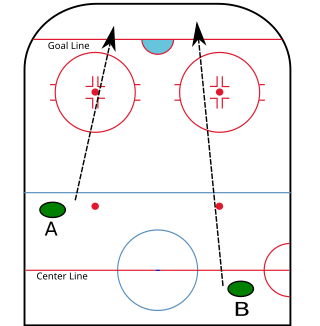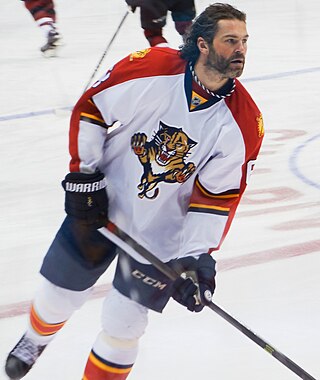
Ice hockey is a team sport played on ice skates, usually on an ice skating rink with lines and markings specific to the sport. It belongs to a family of sports called hockey. Two opposing teams use ice hockey sticks to control, advance, and shoot a vulcanized rubber hockey puck into the other team's net. Each goal is worth one point. The team with the highest score after an hour of playing time is declared the winner; ties are broken in overtime or a shootout. In a formal game, each team has six skaters on the ice at a time, barring any penalties, including a goaltender. It is a full contact game and one of the more physically demanding team sports.

In ice hockey, icing is an infraction that occurs when a player shoots, bats, or deflects the puck from their own half of the ice, beyond the opposing team's goal line, without scoring a goal.
In ice hockey, a forward is a player, and a position on the ice, whose primary responsibility is to score and assist goals.

Winger, in the game of ice hockey, is a forward position of a player whose primary zone of play is along the outer playing areas. They typically flank the centre forward. Originally the name was given to forward players who went up and down the sides of the rink. Wingers generally have the least defensive responsibilities out of any position on the ice, however they are still tasked with defensive duties such as forechecking duties or covering the point in the defensive zone.

Defence or defense in ice hockey is a player position that is primarily responsible for preventing the opposing team from scoring. They are often referred to as defencemen, D, D-men or blueliners. They were once called cover-point.

An ice hockey rink is an ice rink that is specifically designed for ice hockey, a competitive team sport. Alternatively it is used for other sports such as broomball, ringette, rinkball, and rink bandy. It is a rectangle with rounded corners and surrounded by walls approximately 1.22 metres (48 in) high called the boards.

A face-off is the method used to begin and restart play after goals in some sports using sticks, primarily ice hockey, bandy, floorball, broomball, rinkball, and lacrosse.

The neutral zone trap is a defensive strategy used in ice hockey to prevent an opposing team from proceeding through the neutral zone and to force turnovers.
In ice hockey, a play is offside if a player on the attacking team does not control the puck and is in the offensive zone when a different attacking player causes the puck to enter the offensive zone, until either the puck or all attacking players leave the offensive zone. Simply put, the puck must enter the attacking zone before attacking players. If a player on the attacking team is in the offensive zone when the puck enters, either an immediate offside occurs, or they must retreat to the neutral zone.

Inline hockey or roller hockey is a variant of hockey played on a hard, smooth surface, with players using inline skates to move and ice hockey sticks to shoot a hard, plastic puck into their opponent's goal to score points. The sport is a very fast-paced and free-flowing game and is considered a contact sport, but body checking is prohibited. There are five players including the goalkeeper from each team on the rink at a time, while teams normally consist of 16 players. There are professional leagues, one of which is the National Roller Hockey League (NRHL). While it is not a contact sport, there are exceptions, i.e. the NRHL involves fighting.

The Miracle on Manchester is the nickname given to a National Hockey League (NHL) playoff game between the Los Angeles Kings and Edmonton Oilers that took place on April 10, 1982 in the league's 65th season. The game, the third in a best-of-five postseason series, was played at The Forum, the Kings' home arena at the time, which was situated on Manchester Boulevard in the Los Angeles suburb of Inglewood. The Kings completed the largest comeback in NHL playoff history, going from being down 5–0 to win the game in overtime, 6–5. Combined with upset wins in Games 1 and 5, the Kings eliminated the Gretzky-led Oilers in a 3–2 series victory to reach the second round.

The National Hockey League rules are the rules governing the play of the National Hockey League (NHL), a professional ice hockey organization. Infractions of the rules, such as offside and icing, lead to a stoppage of play and subsequent face-offs, while more serious infractions lead to penalties being assessed to the offending team. The league also determines the specifications for playing equipment used in its games.
This is a list of common terms used in the sport of ice hockey along with the definitions of these terms.
Loafing, floating, or cherry picking in ice hockey is a manoeuver in which a player, the floater, literally loafs — spends time in idleness — or casually skates behind the opposing team's unsuspecting defencemen while they are in their attacking zone. It is very similar to the cherry picking tactic sometimes used in basketball. Its controversy is also very similar to that of cherry picking in basketball.
In ice hockey, a line is a group of forwards who play in a group, or "shift", during a game.
The forecheck is an ice hockey defensive coverage play made (primarily) in the offensive zone with the objective of applying pressure to the opposing team to regain control of the puck. It is a type of checking. Forechecking is generally executed in one of three situations: recovery of the puck after a dump in, after the rebound following a scoring attempt, or immediately after a turnover to regain possession. Forechecking can be aggressive or conservative depending on the coaching style and on the skating skills of the players.
In ice hockey, a pass is the movement of the puck from one player to another, usually by a motion of the stick. A pass differs from a shot, in that a pass is typically weaker than a shot and is not directed at the opponent's net with the intention of scoring a goal. The function of passing in ice hockey during gameplay strongly resembles the role of passing in other goal sports such as soccer and lacrosse. Passing is one of the most fundamental skills in hockey. An effective pass is described as being "stick to stick" or "tape to tape", referring to the tape on the blade of a hockey stick. Effective passing requires good vision, anticipation, and timing, as well as execution. A player that is an effective passer will normally record many assists, which are awarded to the second and third to last player to touch the puck before a goal. The National Hockey League record for most career assists is 1,963 by Wayne Gretzky, who is considered one of the best passers of all time. Different types of passes are employed in different situations or using different techniques:
The 2-1-2 forecheck, or pinch on a wide rim is an ice hockey forechecking strategy which uses two forwards deep in the offensive zone, with the remaining forward positioned high in the offensive zone, and the two defencemen positioned at the highest part of the zone near the blue line. This forecheck is used to apply both mental and physical pressure on the opposing team as they try to move the puck out of their defensive zone with objective of forcing a turnover. The positioning of the players removes options for moving the puck along the boards, forcing the play to the middle.
The backcheck is an ice hockey defensive transition play made (primarily) in the neutral zone. It is a type of checking. The purpose of the backcheck is to try to limit the opponents options as they head up the ice towards the backchecking team's end zone. The backcheck may be initiated by situations such as having lost the puck in the opponent's half of the ice, the opponents having played through the first line of pressure in their own end zone, or having lost a faceoff in the neutral zone.

Sports strategy refers to the numerous sets of methods applied in various sports in order to find ways and create advantageous methods for achieving an outcome of success. For team sports, strategy largely consists of how to coordinate the internal movements and positioning of players in a team. For individual sports, strategy is based on advantages that can be found in various available options for the player.












